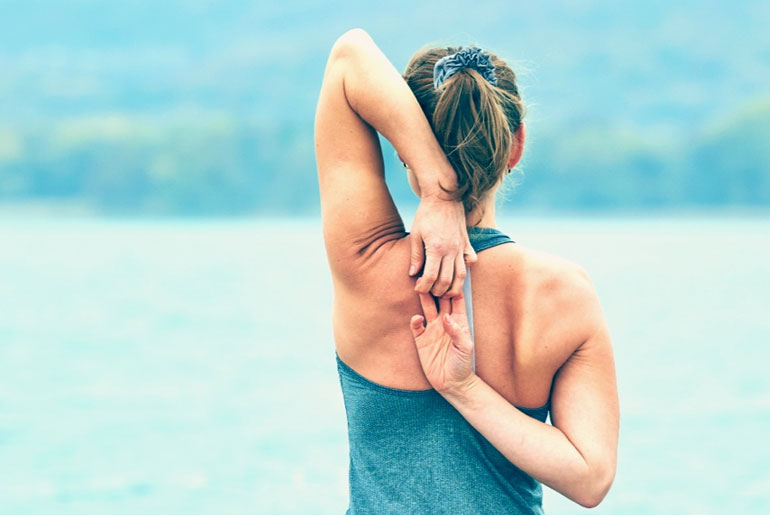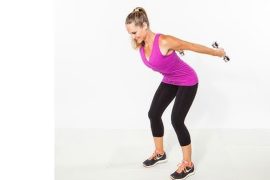If you’re struggling to touch your palms to your shoulders, it could be due to limited flexibility or mobility in the shoulders, upper back, or arms. This difficulty is often linked to tight muscles, poor posture, or lack of shoulder mobility exercises. Incorporating stretches, shoulder mobility drills, and strengthening exercises can help improve flexibility and range of motion, making it easier to perform this movement over time. Consistency and proper technique are key to gradually overcoming this challenge.
Several anatomical factors can influence why some individuals may struggle to touch their palms to their shoulders. These include:
1. Bone Structure:
- Bone Length and Shape: The length and shape of the humerus (upper arm bone) and scapula (shoulder blade) can affect how close the arms can move to the body. Variations in bone length, particularly in the upper arm, can limit the range of motion in shoulder movements.
- Clavicle (Collarbone) Position: The positioning of the clavicle, which connects the sternum and scapula, can influence shoulder flexibility. A shorter or more rigid clavicle could limit the range of motion in shoulder elevation and internal rotation.
2. Joint Capsule and Ligaments:
- Joint Capsule: The shoulder joint is surrounded by a flexible capsule that provides stability. If the joint capsule is tight or restricted (e.g., due to overuse or injury), it can limit the movement of the shoulder joint, making it difficult for some individuals to rotate or move their arm freely enough to touch the palm to the shoulder.
- Ligamentous Restrictions: The shoulder has several ligaments that provide stability, such as the coracohumeral ligament and the glenohumeral ligaments. If these ligaments are tight or stiff, they may limit the range of motion of the shoulder joint, making it harder to perform movements like bringing the palm to the shoulder.
3. Tendon Length and Attachment Points:
- Tendon Length: The length of muscles and tendons around the shoulder joint can influence mobility. For example, short or inflexible tendons in muscles like the deltoid, rotator cuff, and biceps can limit shoulder movement and make it harder to touch the palm to the shoulder.
- Attachment Points: The location of tendon attachments on bones also plays a significant role. Variations in where tendons attach on the humerus or scapula can affect the range of motion in the shoulder. Tendons that are naturally positioned closer to the joint or that have been affected by previous injury or wear can limit flexibility and strength, making certain movements harder to achieve.
In addition to these anatomical factors, external factors like muscle imbalances, previous injuries, and overall flexibility can also contribute to difficulty in achieving full shoulder range of motion.
limited flexibility or muscle tightness in specific areas can significantly contribute to the restriction in touching your palms to your shoulders. Tightness in muscles such as the subscapularis can limit shoulder internal rotation, making it harder to move the arm fully. Inflexible anterior deltoids can hinder the movement of bringing the hand to the shoulder, while overdeveloped chest muscles can pull the shoulders forward, reducing overall mobility. Additionally, tight triceps and biceps affect both the elbow and shoulder joints, and restricted thoracic spine mobility can further impact shoulder flexibility and movement. Addressing these specific areas through targeted stretching and mobility exercises can help improve shoulder range of motion.
Here are some exercises and stretches that can help improve shoulder mobility and increase the range of motion necessary to touch your palms to your shoulders:
1. Shoulder Rotations:
Purpose: Improves shoulder joint mobility and flexibility.
How to Do It:
- Stand tall with your arms by your sides.
- Slowly rotate your arms forward in small circles.
- Gradually increase the size of the circles, making sure to keep the movement smooth.
- After 10-15 rotations, reverse the direction and repeat.
- Perform for 1-2 minutes in each direction.
Tip: Keep your movements slow and controlled to avoid straining the shoulder.
2. Cross-Body Shoulder Stretch:
Purpose: Stretches the shoulder muscles, especially the deltoid and upper back, increasing flexibility.
How to Do It:
- Stand or sit with your back straight.
- Extend one arm out in front of you and bring it across your chest, aiming to touch the opposite shoulder.
- Use the opposite hand to gently pull the elbow toward the chest to deepen the stretch.
- Hold for 20-30 seconds, then switch sides.
Tip: Focus on stretching the back of the shoulder, not just the arm.
3. Thoracic Spine Mobilization:
Purpose: Increases upper back mobility, which is essential for optimal shoulder movement.
How to Do It:
- Sit on a chair with your feet flat on the ground.
- Place your hands behind your head, elbows wide.
- Slowly rotate your upper back to one side as far as possible while keeping your lower body still.
- Hold the position for 2-3 seconds, then return to the center and rotate to the opposite side.
- Repeat 8-10 times per side.
Tip: Keep the movement slow to focus on mobilizing the thoracic spine, not just the shoulders.
4. Triceps Stretch:
Purpose: Stretches the triceps and shoulder, helping improve range of motion in shoulder flexion and extension.
How to Do It:
- Reach one arm overhead and bend the elbow, bringing your hand down behind your head.
- With your opposite hand, gently press the bent elbow to deepen the stretch.
- Hold for 20-30 seconds, then switch sides.
Tip: Avoid arching your back; keep your spine neutral during the stretch.
5. Wall Angels:
Purpose: Improves shoulder mobility, posture, and thoracic spine movement.
How to Do It:
- Stand with your back against a wall, feet a few inches away, and your lower back, upper back, and head pressed against the wall.
- Raise your arms to form a “W” shape with your elbows bent at 90 degrees, ensuring your upper arms and forearms are touching the wall.
- Slowly slide your arms up the wall, keeping contact with the wall the entire time, until your arms are fully extended overhead (forming a “Y” shape).
- Return to the starting position and repeat 10-15 times.
Tip: Focus on maintaining proper posture and engaging your core during the movement.
By incorporating these exercises and stretches into your routine, you can improve shoulder mobility and flexibility, ultimately helping you achieve the range of motion necessary to touch your palms to your shoulders. Always perform these exercises gently and avoid forcing any movement.
Disclaimer:
The information contained in this article is for educational and informational purposes only and is not intended as a health advice. We would ask you to consult a qualified professional or medical expert to gain additional knowledge before you choose to consume any product or perform any exercise.







